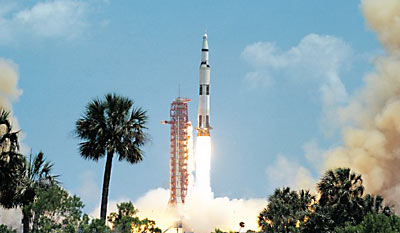The future of the US human spaceflight program is not reliving its pastby Roger Handberg
|
| For too long, space advocates have acted as faithful believers that the president will save the program and raise NASA up to the earlier levels of the 1960s and 1970s. |
The Constellation program was an almost desperate Hail Mary pass to the future by recycling parts of the Apollo concept. Everything came to a thud rather than a crescendo in 2010. Many attributed NASA’s crisis to the Obama Administration, rather than acknowledging the reality that Constellation was over budget and behind schedule. Such shortfalls had been acceptable in the post-Apollo era. But what changed was the economy, which signaled that secondary and tertiary priorities—like space exploration—would be given no slack and scaled back. Ignoring this economic reality means that the positive developments of commercial space applications finally moving ahead was obscured by the slowdown on human exploration through NASA.
At this point, NASA is in a slowdown rather than a stand down. After Apollo, a similar situation arose, but the Apollo-Soyuz Test Project mission and the three earlier Skylab missions disguised that event. Those were part of the rundown of the Apollo program hardware rather than a step into the future. Likewise, presently, the ISS continues to operate along with US crewmembers who, however, arrive on Soyuz vehicles. They may in the future arrive on a commercial vehicle, the crew-rated SpaceX Dragon being perhaps the leading contender.
The fiscal cliff, embodied in the budget sequestration, further hampers any dramatic rebooting of NASA’s efforts. Funding is being hit, but that is across the board at this point rather than targeted at specific programs. If cuts become program specific, NASA may be in severe peril. For the time being, NASA actually continues to do well in terms of its budget considering its relatively weak political position. What may save NASA is its fostering of commercial flight to low Earth orbit and the ISS. Once operational and routine, NASA’s focus can return to its two pillars: space science across the spectrum of scientific research, and human exploration. Hopefully, the two can be clearly linked and mutually supporting rather than fiefdoms struggling to go their own way.
| Reinventing the past is the route to failure and disappointment. One must build in order to go forward. |
This perspective assumes that commercial space activities will in fact lower the cost to orbit. NASA will then be able to leverage that cost reduction to build depots supporting exploration outward from Earth orbit rather than continually lifting the entire expedition to orbit and beyond on one vehicle. The Apollo mission plan existed because there was no infrastructure in orbit and the political imperatives were considered so unforgiving. The future should be seen sequentially or as a cumulative activity. One builds on prior successful activities rather than doing space de novo each time a mission departs for a new destination.
Reinventing the past is the route to failure and disappointment. One must build in order to go forward. Apollo was the product of a moment in time, but the future is different. The United States does not write on a blank slate or a blank check—others are also in space. Much of what they do is duplicative, rehearsing Apollo’s past. For the United States, that past must become prologue.
